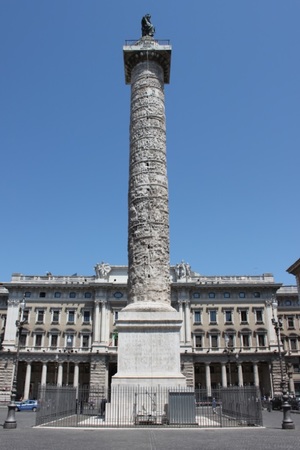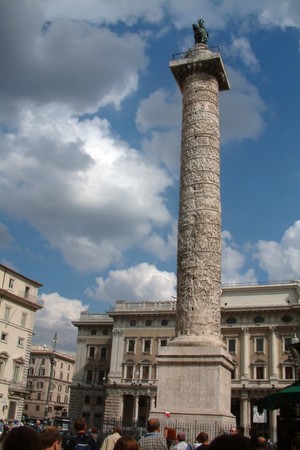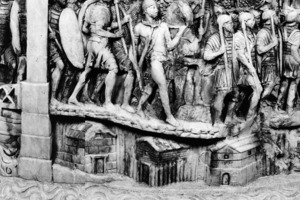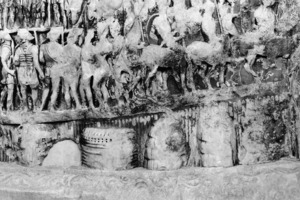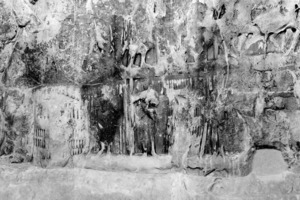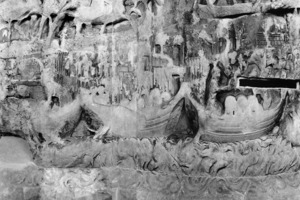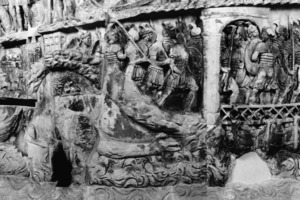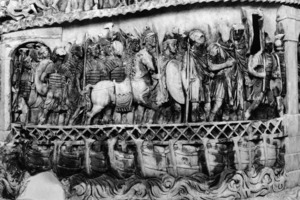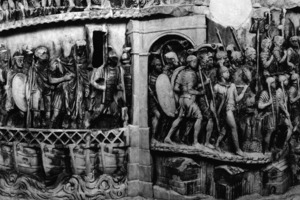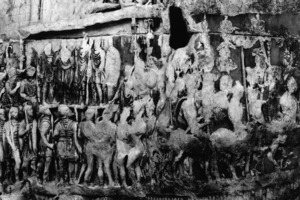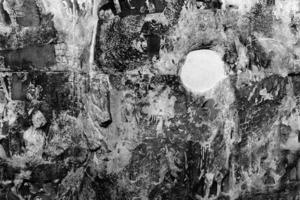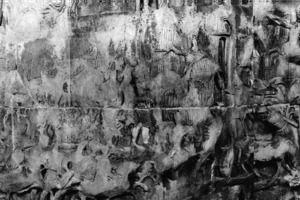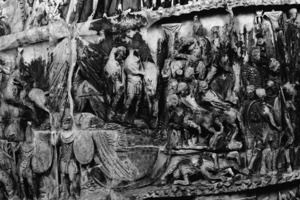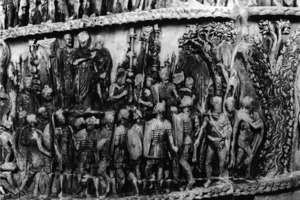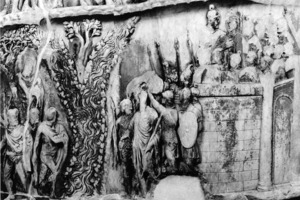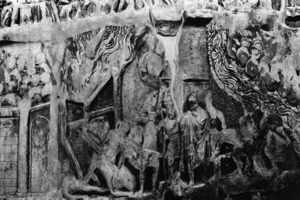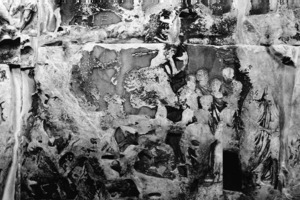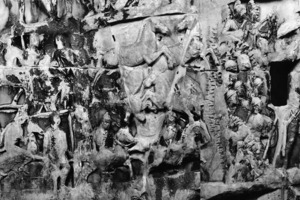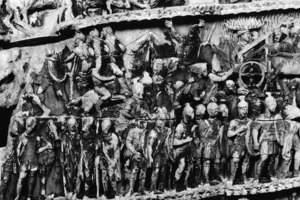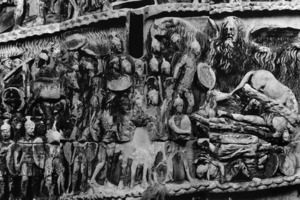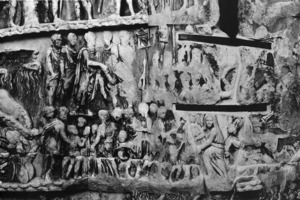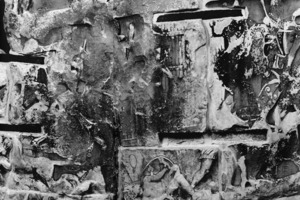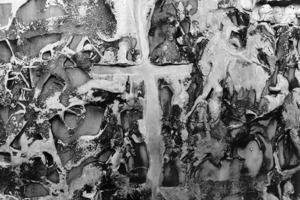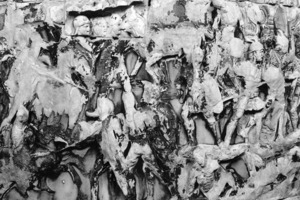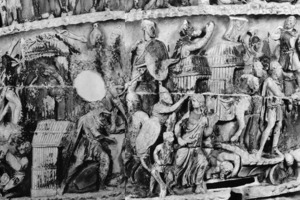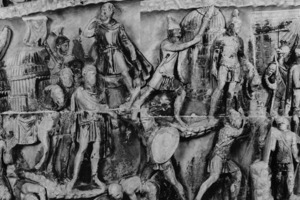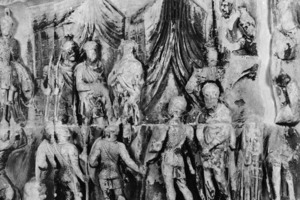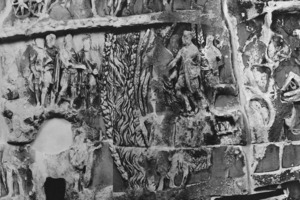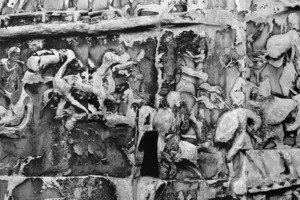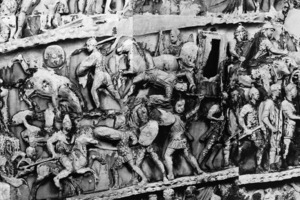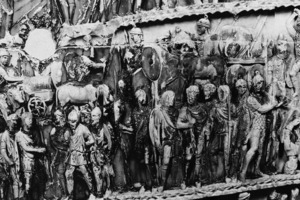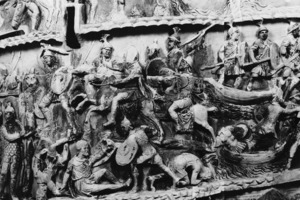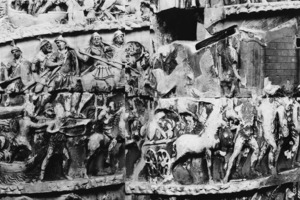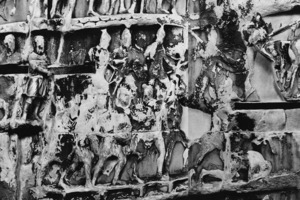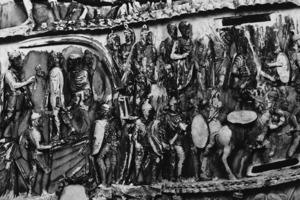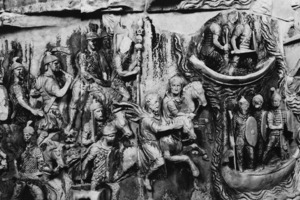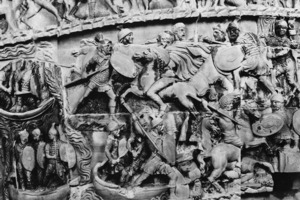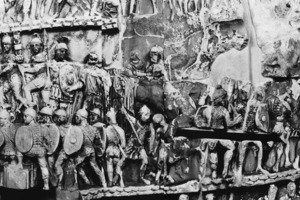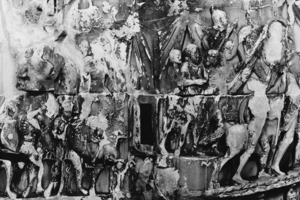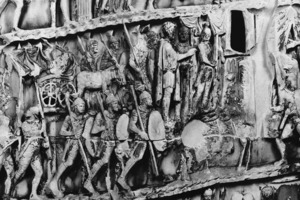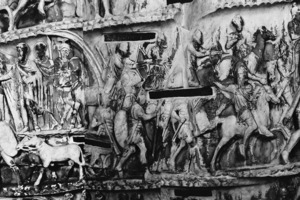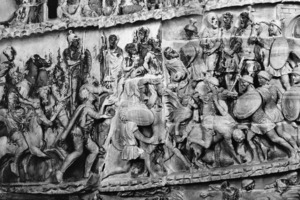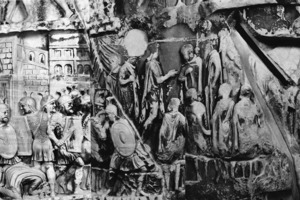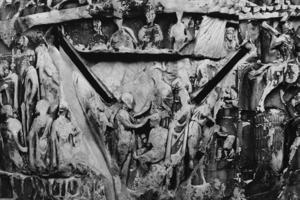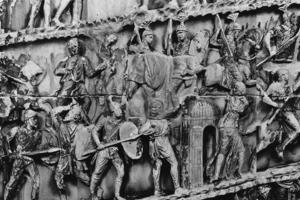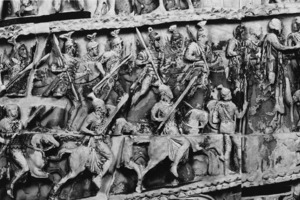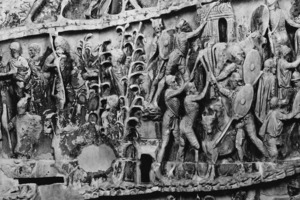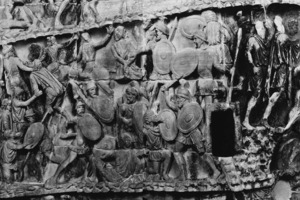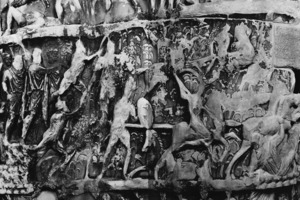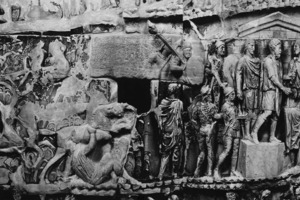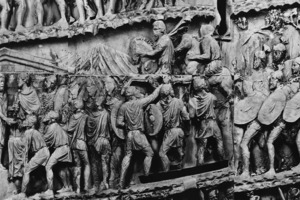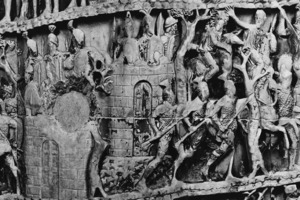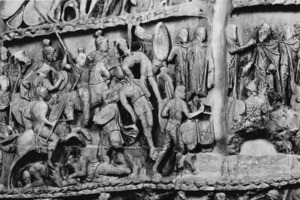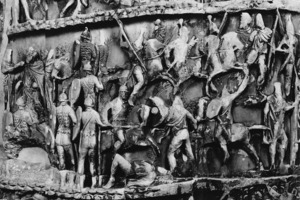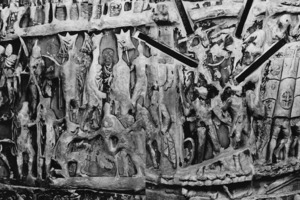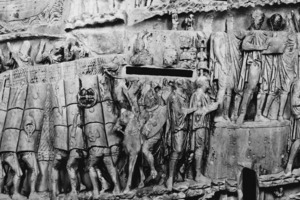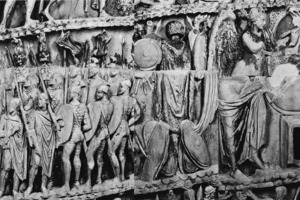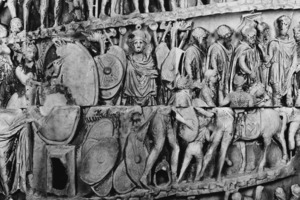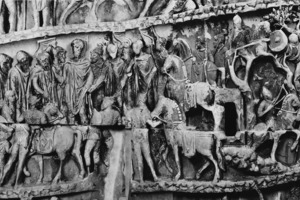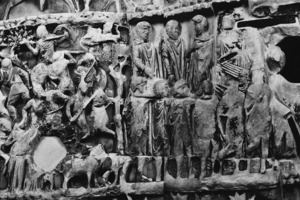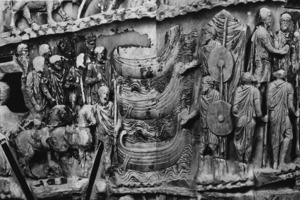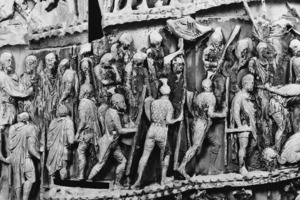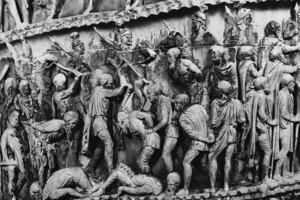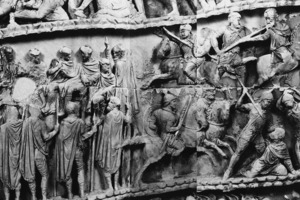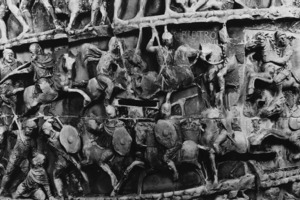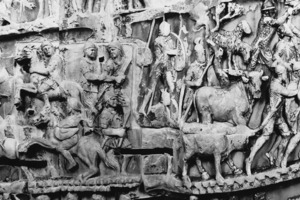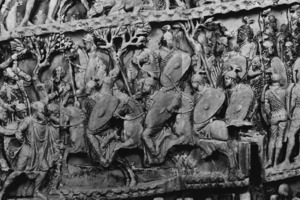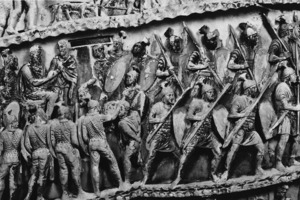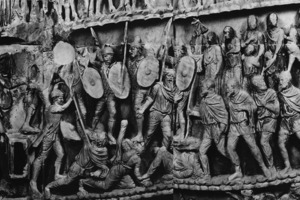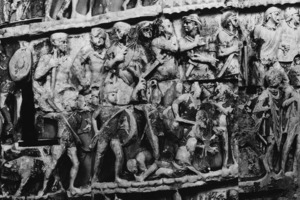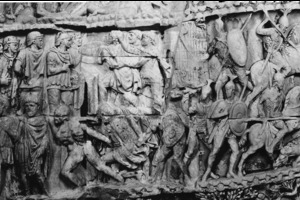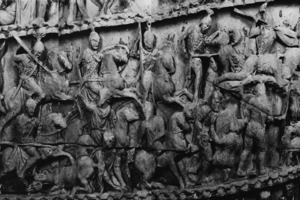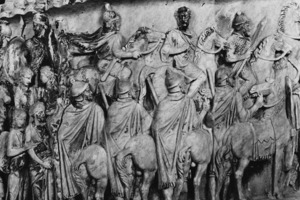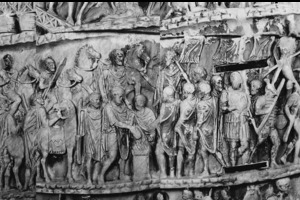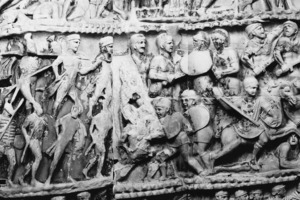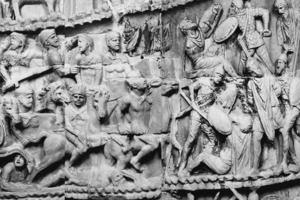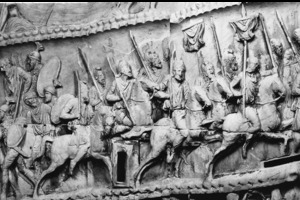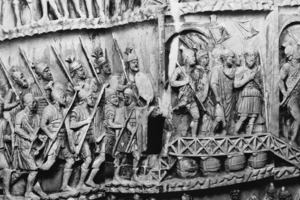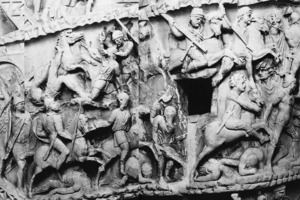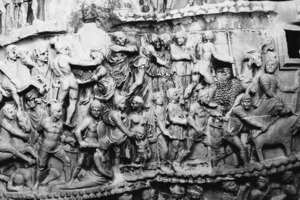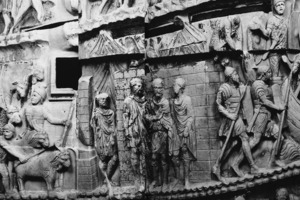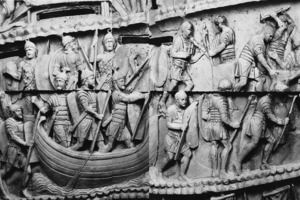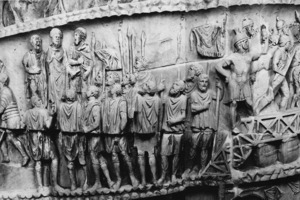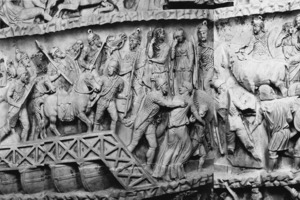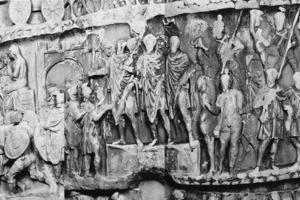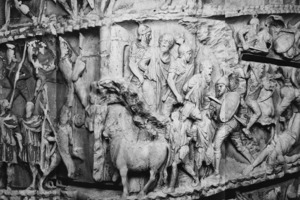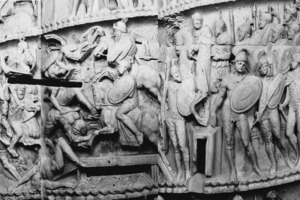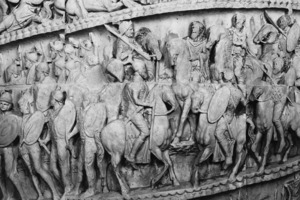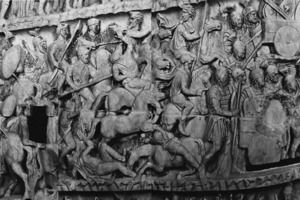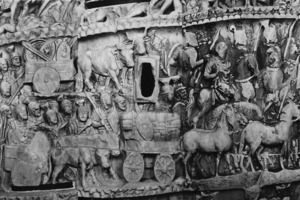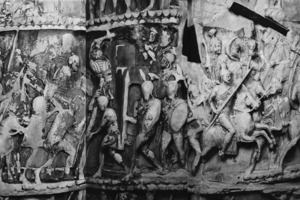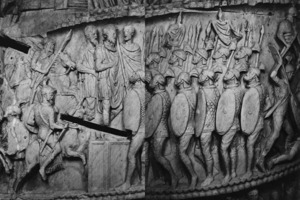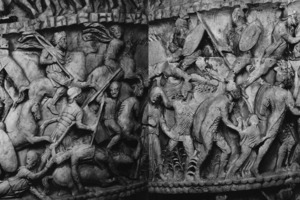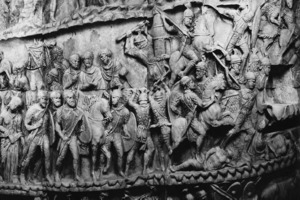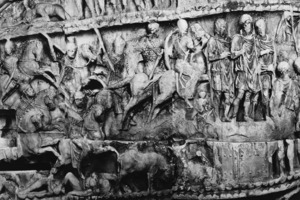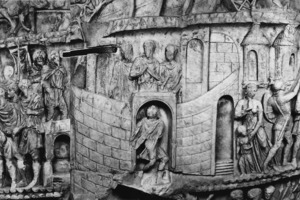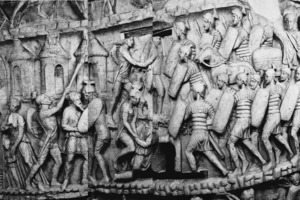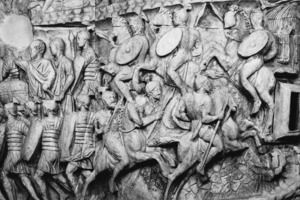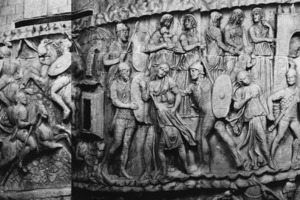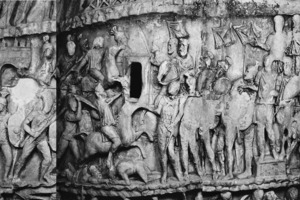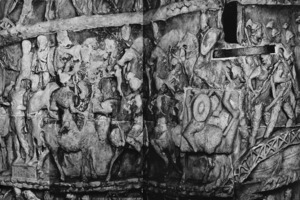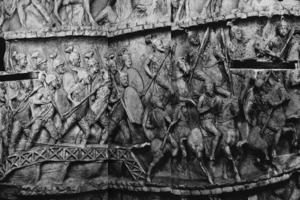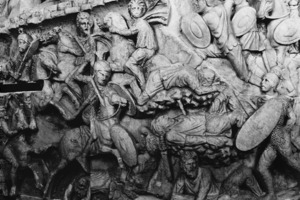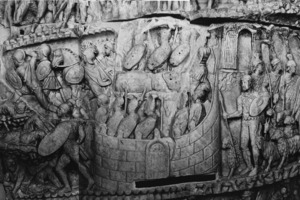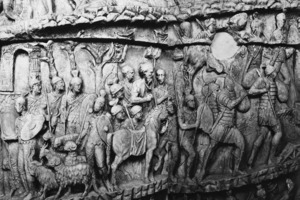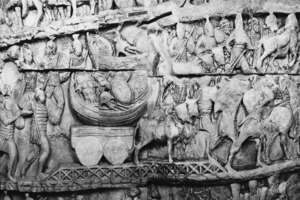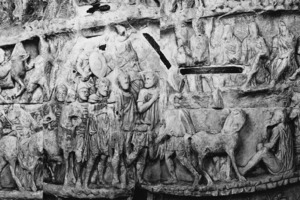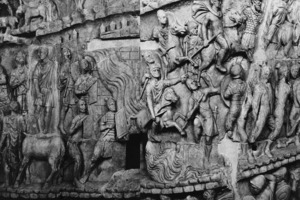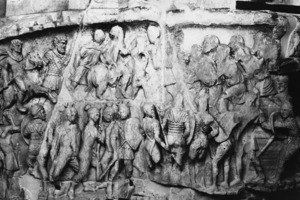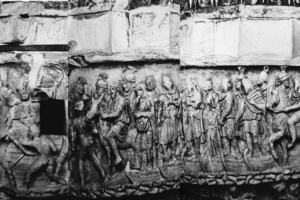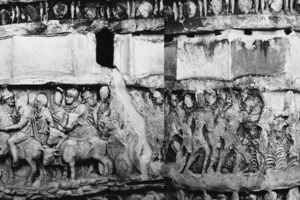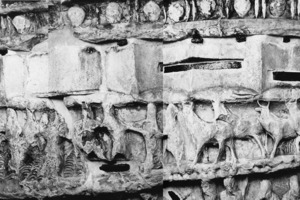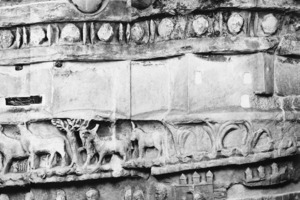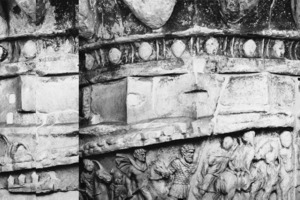Column of Marcus Aurelius
The Column of Marcus Aurelius (Latin: Columna Centenaria Divorum Marci et Faustinae, Italian: Colonna di Marco Aurelio) is a Doric column located in Rome on the square named after it, Piazza Colonna. It was erected between 176 and 192 CE in memory of Marcus Aurelius' Marcomannic Wars, with the Column of Trajan serving as its prototype.
The height of the column is 29.6 meters, and its pedestal measures 10 meters. The total height of the monument was 41.95 meters, but after the restoration in 1589, 3 meters of its base were found to be below ground level. The shaft of the column consists, according to different sources, of 27 or 28 blocks of Carrara marble with a diameter of 3.7 meters. Like the Column of Trajan, it is hollow inside and contains a spiral staircase with 190-200 steps leading to the top, where a sculpture of Marcus Aurelius was originally placed. The stairwell is illuminated through small slits.
The relief on the Column of Marcus Aurelius noticeably differs from the relief on the Column of Trajan in terms of greater expressiveness. The play of light and shadow is more pronounced, as the stone carving is deeper, and the heads of the figures are slightly enlarged to convey facial expressions more accurately. At the same time, there is a decrease in the level of detail in the depiction of weapons and clothing.
The base of the column was adorned with reliefs that were lost during the restoration carried out by Domenico Fontana in 1589. Instead of the original sculpture depicting the Roman emperor on top, a bronze statue of Saint Paul was placed. The spiral staircase passes through the interior and receives illumination from small slits.
Along the surface of the Column, in a continuous frieze covering the entire shaft, the narrative of two military campaigns of Marcus Aurelius against the Germans (172-173 CE) and the Sarmatians (174-175 CE) is depicted separately from the personification of winged Victory, writing the triumph of the Roman Empire on an oval shield.
The oldest and most well-known series of photographic reproductions of the marble frieze dates back to 1896 and was published in the volume "Die Marcus-Säule auf Piazza Colonna" in Rome, edited by Eugen Petersen, Alfred von Domaszewski, and Guglielmo Calderini. This edition established the subdivision of the frieze into separate scenes (from I to CXVI), which has been adopted in subsequent scholarly studies.
The following photographs were taken in 1988 by the Roman photographer Pasquale Ricci on behalf of the Rome Archaeological Excavations Office and show the state of preservation of the Column at that time.
The images fully reproduce the frieze, spanning the shaft in 21 coils, from bottom to top and from left to right. The starting points of the coils are aligned with the openings corresponding to the original door of the base. Four axes of windows divide each coil into quadrants. Each quadrant is represented in 4 photographs, and each coil is depicted in 16 photographs. The photos show overlapping of figures by one-third or one-half; the sequence becomes slower due to mishaps and additions.
Next to each series of images, there is also a description of the scenes based on the text by C. Caprino, A. M. Colini, G. Gatti, M. Pallottino, P. Romanelli, "Colonna di Marco Aurelio," illustrated by the Municipality of Rome (Studies and Materials from the Museum of the Roman Empire, 5, published in Rome, Typo "Erma" Bretschneider, 1955).
The photographs of the reliefs are divided into two sections: the first relates to the campaign of 172-173 CE, and the second to the Germanic-Sarmatian War of 174-175 CE. In an additional section, there is a description of Marcus Aurelius' Germanic wars written by Dio Cassius (Roman History, LXXI, abridged by Xiphilinus), published by Filippo Coarelli in "La Colonna di Marco Aurelio," Rome, Colombo Editions, 2008.

 Column of Marcus Aurelius - the Marcomanian War
Column of Marcus Aurelius - the Marcomanian War







 First level of the column
First level of the column






Scene 1: Houses, Palisade, and Main Guard along the Danube
Four houses are arranged along the banks of the Danube, on the outer side of the palisade, which possibly encloses the port of Carnuntum. The first, second, and fourth houses have Roman structures: two of them are made of stone, with a square isodomic construction and pitched tile roofs.
Located outside the palisade, the second, third, and fourth houses, in turn, are surrounded by defensive enclosures made of pointed stakes, very similar to lime trees. The partially open door of the enclosure of the second house has a hammer-shaped lion's head. On the other hand, the structure of the third house and its enclosure is different. It is of indigenous type, covered, it seems, with layers of reed even in the pitched roof, and has a quadrangular plan. The enclosure consists of dispersed stakes connected by horizontal beams, and the windows resemble those of Roman-style houses, while the arched door is of a local type, typically found in houses of this kind depicted on the column. Behind the houses, there are piles of logs, reeds, and hay gathered around a central column used for long-distance signaling, and three guard rooms with Roman sentries standing facing the river next to them. They are armed with a spear in their right hand, resting on the ground, and a shield to their left. The guard rooms are protected by palisades equipped with observation platforms, and from the window of one of them, a column protrudes, which Petersen considers to be a lantern.
Scene 2: River Communication in Carnuntum
On the banks of the Danube, there is the village of Carnuntum, the headquarters of the emperor. On the quay of the small river port, barrels and perhaps crates are piled up. Three fully loaded boats are positioned by the shore, and in two of them, the first and third, two Roman soldiers are unloading or loading the barrels. The settlement is surrounded by a palisade, which is impressive with its beautiful construction: a building with a colonnade featuring columns and pillars, houses constructed in a square shape with numerous windows, and a two-story building. In front of one of the houses, a tree stands tall, while cypresses adorn the courtyard of another, possibly not a private house but a sanctuary.
Scene 3: Romans Crossing the Danube
From the waves of the river emerges the personification of the Danube, bearded, with only the upper part visible from the back, but clearly imagined lying down, according to the iconographic scheme common to river deities. The god, with a benevolent expression, extends his right hand, inviting the Roman army to cross the river.
The crossing takes place on a stable bridge, indicated by two arches rising at the end, supported by nine boats and a parapet. The rear of the column, arranged in three rows, is composed of legionnaires wearing lorica segmentata armor over their tunics. Some also have pteruges and helmets adorned with plumes, oval shields, spears, and swords hanging from their right side. In the center is the emperor (whose face is heavily damaged), dressed in armor and a tunic, holding a spear in his lowered left hand. Next to him are two officers, one of whom is possibly a Pompeian, the son-in-law of Marcus Aurelius, and the other, unrecognizable, without armor but holding a spear in his right hand.
The emperor's horse, harnessed and with a rich saddle, is led by one of the three bodyguards following him. One of them wears lorica hamata (mail armor), and the other, who also carries a rectangular shield, wears lorica squamata (scale armor). The armor of the third is not visible because it is covered by the horse. All three have helmets with a hanging ring, wearing something like a sagum and armed with spears. Other legionnaires open the march, including two soldiers wearing mail armor and a wild animal skin on their heads, a guardsman with mail armor, breeches, and a sagum, leading a horse by the reins, and a standard-bearer, also wearing mail armor and clothing covered with a wild animal skin.
The Romans first crossed the Danube in 172 AD for an offensive on enemy territory. According to Domashevsky, the Romans crossed in Carnuntum (now Petronell), while according to Gnirs, it was in Bratislava (previously Pressburg).

 Second level of the column
Second level of the column






Scene 4: Marcus Aurelius Addressing the Army
On a rocky ascent, standing between four characters from his entourage, the emperor is depicted with a spear and a vest, but without armor. On both sides of the podium, there are two signifers wearing scale armor and wild animal skins on their heads, as well as a bearer of a curved rod, possibly a lictor without fasces. Below them, legionnaires (on the left) and imperial bodyguards (on the right) face the emperor, who is delivering a speech (adlocutio) prior to the commencement of military operations.
Scene 5: Roman March to the Stable Camp
This scene is heavily damaged. Horsemen and infantrymen with flags and distinguishing marks are advancing accompanied by two horsemen in togas, one of whom could be Marcus Aurelius. They are depicted in front of a fort or a stable, built in a square shape. This fort suggests to Cvikker that even before the major offensive, the Romans constructed this fortification to protect an important road along the Morava River (ancient Marus, a tributary of the Danube).
Scene 6: Sacrifice
In this scene, which is also heavily damaged, many details were reconstructed by Petersen based on similar scenes in Trajan's Column. It appears to depict the lustratio exercitus, that is, a sacrificial ritual preceding the onset of war. Near the stable or fort from the previous scene, where he stands on guard, a figure dressed in a toga emerges to identify himself as Marcus Aurelius, surrounded by his retinue. The animals of his ovetarii, including a bull, a ram, and a boar, led by camilli, were also identified, along with official figures, sacrificial offerings, and musicians playing wind instruments, seen through a door.
Scene 7: Romans Destroying an Abandoned Germanic Settlement
After the door in Scene 6, Petersen identified traces of a Roman soldier half-lying on the ground with his head disappearing towards the back wall, against which a shield is leaning, and a horse next to him. Cvikker does not accept Petersen's interpretation that he is a fugitive or messenger, as a messenger would have caused the knights, infantry, legionnaires, and bodyguards to rush to the right, while some observers are watching this scene from above. Petersen also identified traces of a transport wagon. Ahead, the emperor with his spear lowered on the left, together with two attendants, observes the soldiers entering the abandoned village and destroying it. Houses are set on fire with torches, and at the edge, two legionnaires, one of whom has placed his shield down, are also engaged in demolishing work with a pickaxe. Next to them, a horse is grazing, presumably belonging to a Roman knight as it is harnessed, and grains are depicted, indicating that it is a summer campaign. Four houses in the settlement have a round plan, and the fifth one is square. They are constructed from logs tied together with interwoven ropes. After the lustratio (Scene 6), the army crossed the empire's border.
Scene 8: Germanic Horsemen in the Presence of the Emperor
On a rocky ascent, in front of a large tent of the Roman camp, the wall of which is depicted at the bottom, Marcus Aurelius, wearing armor, a vest, and holding a spear, is on the left surrounded by three officers, receiving two saddle-less and bridle-less Germanic men on horses, led by a standard-bearer in knitted armor and other warriors, presumably a vexillatio. Due to the fact that the two barbarians are on horseback, Cvikker, along with Petersen and others, does not believe that they are prisoners, but rather deserters seeking protection. Along with this, the assumption that they face the same fate as the barbarian above, with the Roman officer holding a sword against him, a fate from which he tries to escape by appealing to the heavens, also collapses. Two other barbarians have been executed and are already dead on the ground. Due to the difference in attire, one of the Germans should be considered of high rank, while the other, like the one about to be slaughtered, is of lower status. The barbarians have smooth heads and beards that completely cover their cheeks. Two sentinels next to the tent are a restoration.
Scene 9: The Emperor Reads the Order to the Troops
Between Pompeius and another character, the emperor reads a proclamation from a scroll to the assembled troops, bodyguards, and legionnaires gathered at the bottom from the top of a rocky elevation. The standard and signifiers frame the scene.
Scene 10: Germans Defending the River Crossing
At the confluence of the rivers, where a beech tree stands, four partially clad Germans, armed with slings and stones, menacingly and hostilely gaze at Marcus Aurelius. The emperor, who has emerged from a fortified Roman castle on the opposite bank, speaks to them. Standing next to the emperor is a fully armed member of his retinue, and behind them are legionnaires and bodyguards, protecting him with their shields. Marcus Aurelius is not wearing armor but holds a spear in his left hand.
Soldiers observe the events from the top of the castle. According to Cvikker, the castle is further evidence that the Romans were preparing an offensive even beyond the Danube. For Domashevský, these barbarians and representatives of the next scene, the Quadi, the event takes place on the southern border of the territory of this people, where the Taya (Dyje) flows into the Morava. On the other hand, for Gnirov, this location is the confluence of the Igława and Schwarzawa (Svratka) rivers, which meet to the north of the Taya, into which they flow.
Third level of the column
Scene 11: Divine Thunderbolt
The castle from the previous scene is attacked by an enemy siege engine, which, struck by lightning, collapses onto the partially fallen barbarians. Marcus Aurelius witnesses the scene involving the Praetorians and legionnaires. The castle features a closed door surrounded by columns. Here, an event from 172 years ago is depicted, where the emperor, finding himself in a difficult and uncertain position, prays to the gods. The gods intervene on his behalf, striking and destroying the siege engines with lightning. The process of prayer is not depicted in the relief.
In the second part of the scene, on the riverbank with rocky shores, two legionnaires stand (one high above the emperor, the other on the lower right, leaning). They may be surveyors measuring the terrain. The legionnaire on the far right seems to be attempting to deceive the barbarians, who have been thrown across to the other bank to protect the passage, and he spies on them.
Scene 12: Romans and Barbarians Fighting for Territory
The scene is heavily damaged. From left to right, we first see two Romans engaged in peaceful activities, then two others attacking and surrounded by riders. At the top, an archer with a bent bow has already released an arrow, which is about to strike a barbarian with a shield, who has fallen to one knee. Another barbarian is already defeated in front of him. At the bottom, a barbarian pushes a bull forward towards two other barbarians. An enemy rider rushes to defend the animal, while a legionnaire advances to meet him.
It is unlikely that the Romans would depict an episode on the column celebrating their victory, in which they actually suffered a defeat. If that were the case, why didn't the artist also depict the killing of animals by the Germans? The strange presence of these two animals remains unclear. Perhaps it is best to adhere to Petersen's hypothesis of iubati bisontes, although it raises many questions. In any case, this scene is far from providing evidence of chronological inaccuracy regarding the historical sequence of events on the column, as convincingly refuted by Cvikker.
In the second part of the scene, on the riverbank with rocky shores, two legionnaires stand (one high above the emperor, the other on the lower right, leaning). They may be surveyors measuring the terrain. The legionnaire on the far right seems to be attempting to deceive the barbarians, who have been thrown across to the other bank to protect the passage, and he spies on them.
Scene 13: The Emperor Makes Sacrifices for the Successful Crossing of the Troops Across the River
At the river with rocky shores, Marcus Aurelius, wearing a tog with a covered head, offers sacrifices on a tripod brazier for the success of the campaign. Meanwhile, six legionnaires cross the river on two boats. At the same time, a barbarian rider spies on them, sending another to inform his people about the Romans' landing. Due to the damaged relief, it is not possible to definitively identify the animals, but they are often considered to be lions. Some historians associate this scene with an episode described by Lucian (Alexander s. Pseudomantis, 48): the priest Alexander of Abonoteichus demanded the sacrifice of two lions during the war in Germany to achieve victory and peace. However, the wild beasts, after crossing the river, were killed by the barbarians, and soon after, the Romans suffered a major defeat. Dobiás, dating the event to either 166 or 169 AD, along with other historians, was forced to admit that the sequence of scenes on the column is not chronologically accurate. Therefore, many episodes will be presented
Zwikker, who supports the opposite thesis, that is, the chronological order of the scenes, considers Dobias' hypothesis to be lacking sufficient evidence, as it is far from certain that this specific historical episode is depicted. As arguments, he points out that it is far from certain that lions are depicted here and that animal sacrifices are a sufficiently common practice among priests in general. Furthermore, it is unlikely that the Romans would depict an episode associated with their defeat. Also, the actual killing of the animals is not depicted on the column, which makes Zwikker's theory the most plausible.
Scene 14. Marcus Aurelius Observes the March of the Cavalry in a Mountainous Area
The scene is poorly preserved. Sitting on top of a platform surrounded by three bodyguards, with legionnaires standing below, the Emperor observes the march of the Roman cavalry through the mountains. The right part of the relief has undergone modern restorations and alterations.
Scene 15. Continued March in the Mountains and Battle
Praetorians and legionnaires emerge from the mountains. In the upper part, Eastern archers - auxiliaries (sagittarii) - attack the barbarians armed with spears and shields from both sides. One of the barbarians, possibly a messenger, gallops to the left. At the bottom, the Emperor is depicted, with a Praetorian holding his horse by the reins.
Scene 16. The Miracle of Rain
Having left the camp (indicated by a tent), the army has stopped. Legionnaires, along with a legate, can be seen below. Above them, three bulls are depicted, one of which is dead. Next to them, a legionnaire is looking up to the sky (possibly invoking rain, which is visible further away). Near the wagon with a ballista and mules, a legionnaire is feeding his horse. Another legionnaire is quenching his thirst, while a third one seeks shelter from the pouring rain under a scutum.
The scene represents the "miracle of rain," which later Christian culture attributed to the intervention of prayers by Christian legionnaires. The rain brings salvation to the thirsty Romans and destruction to the barbarians. This event is described by Dio Cassius (VII acclamatio imperatoria), and the most probable dating is 174 AD. However, there are alternative opinions regarding the dating, suggesting 171 and 172 AD. Alternative sources mentioned include Jerome's Chronicles of Eusebius and Prosper of Aquitaine (Prosperi Tironis). If we adhere to the version that identifies the scene with Eusebius' chronicle, then the commander of the Roman army depicted in the scene is Pertinax.
Fourth level of the column
Scene 17. Marcus Aurelius Receives the Germans
On a rocky elevation, surrounded by his retinue, the Emperor receives a German leader who bows to kiss his right hand. Below, a group of Germans has gathered, including women and children. They may be intended to be handed over as hostages. The women are dressed in long sleeveless tunics cinched at the waist, over which they wear a cloak with long sleeves. Some of them have their heads covered with fabric. The children are dressed in the same costumes as their parents. Two Roman vexillarii stand at the top.
Scene 18. Battle around the German House
The scene is poorly preserved and has undergone restoration, which poses problems with its interpretation. According to one version, there is a square-shaped German house at the center, constructed from tree trunks tied with interwoven ropes. Perhaps this is the house of the leader. A battle is taking place around it: at the top left, a barbarian being pursued by a Roman runs to the left, where another Roman advances, leading a horse with a defeated enemy lying beneath it; another fallen barbarian stands behind the fleeing horse. To the right of the house, a barbarian with a shield and sword confronts a Roman horseman, while three Romans attack another one sitting under an oak tree.
Scene 19. Flight of the German Leader
Two horsemen and several legionnaires launch an attack, encountering three barbarians armed with shields and spears. Behind them, other fallen barbarians lie, having died in the haste of their leader's escape, who is riding a horse. Legionnaires and vexillarii look up towards the fleeing man.
Above them, in front of a tent, Marcus Aurelius stands with a spear but without armor. His retinue stands next to him. They observe a wagon pulled by oxen and controlled by a Roman. A captive woman, possibly the daughter of the German leader, is located there.
Scene 20. Destruction of the Village
Praetorians and horsemen set off from the camp to attack a village weakly defended by the barbarians in order to destroy it.
Scene 21. Prisoners Led to the Emperor
Marcus Aurelius stands before two very wealthy horsemen. One of them, possibly Pertinax, is in muscle armor, a helmet, and holds a spear. They are leading a high-ranking German with his hands tied in front and his wife, dressed in a long gown, followed by at least two legionnaires. Above, auxiliaries accompany two captured bulls.

 Fifth level of the column
Fifth level of the column






Scene 22. Marcus Aurelius Converses with the Germans
The Emperor, in armor, converses with the Germans, who are on the opposite bank of the river with rocky shores. The Germans clearly have different social statuses.
Scene 23. Romans and Allied Germans Fighting Against Hostile Barbarian Tribes
In this scene, we witness the aftermath of the diplomatic negotiations from the previous scene between Marcus Aurelius and the Germans. Romans and Germans fight shoulder to shoulder against a common enemy, whom they attack from both sides. Some hostile barbarians have fallen to the ground with their horses, while others are still riding.
Scene 24. Romans Repelling an Attack from Behind
A new tribe of barbarians wearing conical hats attacks the Romans from behind as they march in the opposite direction. Elite barbarians ride horses and are partially armed with shields and spears.
Scene 25. Barbarians with Conical Headgear Led Captive to Marcus Aurelius
Two barbarians from the previous scene are led as prisoners with their hands tied behind their backs to the armored Emperor, who holds a spear, accompanied by a member of his retinue. Meanwhile, the march, interrupted by the barbarian attack, continues. Legionnaires walk alongside a wagon pulled by mules.
Scene 26. Marcus Aurelius Consulting with His Retinue
The Emperor, with a scroll in hand, stands on the left between three members of his retinue and three warriors, two of whom hold the reins of horses. Above, a wagon loaded with weapons moves in the opposite direction, from right to left.

 Sixth level of the column
Sixth level of the column






Scene 27. Marcus Aurelius Sets off on March with His Retinue
The Emperor, clad in muscle cuirass, rides up the hill with a fully armed officer, possibly Pertinax, next to him, followed by mounted Praetorians. Other infantry Praetorians are seen killing Germans in battle.
Scene 28. Romans Crossing the River, Overcoming Enemy Defense
Roman auxiliaries are crossing the river on two boats. Below, numerous horsemen can be seen galloping into the attack.
Scene 29. Ferry Across the River
At the top of the scene is a fortified Roman camp. Two guards stand watch at a closed door. Petersen suggests that the Emperor is making a sacrifice in front of the castle, but due to the poorly preserved relief and restoration, this hypothesis is difficult to prove. Legionnaires, auxiliaries, and Praetorians are crossing the river on a pontoon bridge in front of the castle. One warrior leads a horse. The vanguard has already begun its battle with the enemy. A barbarian with a round shield and a sword can be seen above, while a Roman strikes him in the back with a spear. Below, a fleeing Roman is chased by a horseman, and a barbarian lies beneath his horse. A Praetorian strikes a defenseless enemy sitting on the ground. Cwikker believes that the scene depicts a battle on the Danube, in an area under constant Roman influence.
Scene 30. Marcus Aurelius Making Sacrifices and the Army Crossing the River on a Pontoon Bridge
Below, the march of the army consisting of Praetorians and legionnaires is shown on a pontoon bridge similar to the one depicted in scene 29. The Emperor is making a sacrifice. Standing next to him is an old ma
Scene 31. Marcus Aurelius and Two German Leaders Conclude a Treaty
The action takes place in the Roman camp, the wall of which is schematically visible on the right side. Two tents are shown below, guarded by sentinels. At the top, the Emperor is depicted, followed by two members of his retinue. In front of them stand two distinguished Germans. The barbarians are likely swearing allegiance to the Emperor.
Scene 32. Beginning and End of the March
Praetorians and legionnaires set off on the march and stop near the Emperor, who stands next to two members of his retinue.
Scene 33. March to the River with the Emperor at the Head
In this scene, legionnaires and Praetorians, some leading horses, march rapidly toward the river. Marcus Aurelius leads them with his retinue in the front.

 Seventh level of the column
Seventh level of the column






Scene 34. Roman Legionnaires Crossing the River by Boat
Only the first part of the scene is original, the rest is a modern restoration: two boats occupied by legionnaires are seen on the river. At the top of the scene, three legionnaires in armor are ready for an attack. In the lower part of the scene, three legionnaires with different types of armorб— segmentata, squamata, and hamata—are depicted. In the restored part of the scene, another boat and a skirmish with barbarian horsemen are shown.
Scene 35. Roman Army on the March
Legionnaires, led by the Emperor holding a scroll in his hand and accompanied by his retinue, move from right to left. Behind Marcus Aurelius, there is a chariot with two warriors, pulled by mules. Below them, a legionnaire kills a barbarian. This scene has also undergone minor restorations: the upper part of the emperor and his retinue, as well as most of the legionnaire at the bottom (only the legs are original).
Scene 36. Roman Army on the March
The relief is heavily damaged. Legionnaires, Praetorians, and a saddled horse march from left to right.
Scene 37. Marcus Aurelius Observes the Resumption of the Army's March
On a tribune in front of the camp tents, the Emperor, accompanied by his retinue, observes the continuation of the march. One of the horsemen leads a horse, and two vexillarii walk alongside.
Scene 38. Termination of the March
Praetorians and a cart pulled by donkeys and filled with weapons move towards the Emperor with his retinue. Two vexillarii are next to him.
Scene 39. Emperor Reaches the Camp, and the Roman Army Repels the Barbarian Attack
Marcus Aurelius appears at the beginning of this scene in a pose very similar to the previous one, except he holds his cloak in his left hand instead of a scroll. He stands in front of a tent, followed by members of his retinue and a legionnaire. It is also visible how a cart pulled by donkeys and loaded with weapons enters the camp.
In the second part of the scene, a detachment of sagittarii, auxiliaries, and legionnaires marches to repel the barbarian assault. One of them is struck by a Roman arrow in the chest.

 Eighth level of the column
Eighth level of the column






Scene 40. Barbarians Pleading for Mercy from the Emperor
The entire scene has been fully reconstructed due to extensive damage. It depicts a battle in front of the city gates. In the surviving original part, we see barbarians pleading for mercy with outstretched hands, facing Marcus Aurelius. The Emperor was most likely intended to be depicted seated rather than standing, as shown in the modern restoration.
Scene 41. Conquest of the Germanic Chieftain
The Emperor, accompanied by his retinue, faces the barbarian. The barbarian chieftain is dressed lavishly, as are his companions. He holds his right hand on his chest and bows his head in a sign of submission. At the bottom, Praetorians with spears are visible.
Scene 42a. Ceremony in the Roman Camp
This scene is also heavily damaged. On a hill, four sitting Romans observe the action taking place below. In the center, the Emperor, wearing a muscled cuirass and chiton, touches a person with his right hand.
Scene 42b. Arrival of Envoys
This scene is also partially restored. The Emperor receives a senatorial embassy. There is also a version suggesting that it depicts a trial where the accused seeks help from Marcus Aurelius, who ordered a pardon. In this version, the standing person would be the accuser, and the four seated individuals above would form the Emperor's council. According to the main version depicting the reception of envoys, the three Romans should be Roman emissaries from Marcus Aurelius to the Senate, to report on his negotiations with the barbarians.
Scene 43. Romans Attack a Germanic Settlement
In front of two round barbarian houses with dome-shaped roofs, mounted and foot Roman warriors attack noble Germans. One German defends himself with a sword and shield. Nearby, a woman flees from a house, but a horseman is about to strike her with a spear. On the left, a young man near a tree is also being pursued by a horseman.
Scene 44. Romans on the March
Legionnaires, Praetorians, and horsemen march swiftly to the right.

 Ninth level of the column
Ninth level of the column






Scene 45. Emperor Consults with his Retinue about the Surrender of the Germans
Marcus Aurelius stands among his retinue, holding a scroll with his outstretched hand. There is an active discussion about the current situation. Praetorians stand around the Emperor's council.
Scene 46. Destruction of the Village
Six Praetorians set fire to two quadrangular houses. Oxen stand nearby. To the right, a bearded barbarian on his knees pleads for mercy from a legionnaire.
Scene 47. Fleeing Barbarians
This scene can be considered as a continuation of the previous one. Two horsemen with plumes are running ahead. This part of the scene has also undergone extensive restoration.
Scene 48. Pursuit of the Barbarians
On an incline, Marcus Aurelius, accompanied by two members of his retinue, witnesses the fire and destruction of the thickets where the pursued barbarians sought refuge, ultimately being killed by Roman legionnaires and horsemen.
Scene 49a. Emperor Receives an Embassy
Marcus Aurelius stands on a podium in front of a large square building, where two people are present. Praetorians and one German stand behind him. The Emperor receives an embassy of unarmed and high-ranking barbarians. Three of them wear Phrygian caps. Leaning forward, they extend their hands covered with cloaks to seek mercy or express respect.
Scene 49b. March of the Barbarians Accompanied by Romans
Three German infantrymen with shields and three mounted ones walk accompanied by a Roman force that is emerging from a fortified camp. Only Roman soldiers are present in the camp, indicating that the territory is under the control of the Roman Empire.
Scene 50. Victorious Sortie of the Roman Garrison
From another castle, similar to the previous one, in the same wooded area, Praetorians and auxiliaries march in the opposite direction. Also present here, in the fortified camp, are Roman warriors with shields and spears. On top, there are two fleeing barbarians. The Romans have attacked and destroyed the Germans armed with round and hexagonal shields. Some of them are already lying on the ground, while others are still attempting to defend themselves.

 Tenth level of the column
Tenth level of the column






Scene 51. Emperor's Conversation with the German Chieftain
Marcus Aurelius, with his retinue surrounded by Praetorians, receives the German chieftain.
Scene 52. Battle
Roman legionnaires and cavalry attack the barbarians triumphantly. To Petersen, they appear to be Sarmatians, while to Zwickert, they appear to be Germans (the preservation of the relief is poor).
Scene 53. Subjugation of the Barbarians
The relief has suffered significant damage. At the top, Marcus Aurelius is depicted. Next to him are two individuals from his retinue and three standard-bearers. At the bottom left, two Praetorians are present. In the center, beneath the Emperor, the barbarians genuflect.
Scene 54. Assault on the German Fortification
Roman legionnaires, forming a tortoise formation (testudo), storm the fortification constructed from wooden planks tied with ropes. The besieged defenders throw torches, wheels, swords, stones, and containers filled with liquid from above. Roman legionnaires and cavalry attack. It is possible that the barbarians under attack are the Marcomanni, subdued in the year 172 AD.
Scene 55. "Adlocutio" of Marcus Aurelius to the Troops
The Latin word "adlocutio" in Rome refers to the address of a general, usually the Emperor, to his numerous army and legions, and the overall Roman salute of the army to their leader. After the victorious conclusion of the two-year war (172-173 AD), the Emperor addresses his troops with an adlocutio, accompanied by all the regalia and various types of standards. Marcus Aurelius holds an unfurled scroll in his hands, and two members of his retinue stand beside him. At the foot of the tribune, two lictors are present.
Victory
Between the trophies and weapons, the goddess Victoria is depicted, symbolizing Roman triumph. She clearly separates the two years of the war (172-173 AD) from 174-175, depicted in the subsequent scenes.

 Eleventh level of the column
Eleventh level of the column






Scene 56. Marcus Aurelius Receives the Barbarians
The Emperor stands on the tribune between two members of his retinue and standard-bearers. Praetorians holding harnessed horses are positioned at the top and bottom. Marcus Aurelius gazes at three barbarians with bowed heads.
Scene 57. Destruction of the Barbarians
Roman legionnaires and cavalry once again engage in battle with the barbarians, who are defending their families and livestock. One of the horsemen shoots an arrow.
Scene 58. Germans Surrendering Weapons
This scene has been partially restored. At the upper part, Marcus Aurelius is depicted with his retinue, while Germans stand at the bottom.
Scene 59. Germans Led to the River for Crossing
Two armed horsemen escort unarmed high-ranking Germans to the river to be ferried across to the other bank on three boats. Two accompanying Germans hold their horses' reins. On the opposite bank of the river (likely the Danube), two other Germans armed with spears and shields await them, inviting them to join by extending their right hand.
Scene 60. Barbarians in the Presence of Marcus Aurelius
The Emperor stands on the tribune accompanied by a member of his retinue, surrounded by spear-wielding Germans. Two higher-ranking barbarians stand before him. Petersen believes they are accusing those who will be executed in the next scene.
Scene 61. Beheading of the Rebellious Barbarians
At the top left, a group of women in sorrowful yet resigned poses is depicted. At the bottom, Praetorians, one of them holding a standard, advance toward the execution site, accompanied by cavalry and legionnaires. Two Germans are about to be beheaded. Another two already lie on the ground with their heads severed next to them.
These scenes are often associated with the events of 174 AD. Part of the barbarians, led by the new king Ariogaesus, who replaced King Furtius, rebelled against the Romans and undermined the terms of the peace established in 172 AD. They also rallied many additional tribes and allies to their side in the struggle against the Romans. These scenes illustrate the disobedience followed by disarmament (scene 58), transportation (scene 59), and beheading by the hands of their fellow countrymen who remained loyal to Rome. These events are also represented in chronological order on the column.

 Twelfth level of the column
Twelfth level of the column






Scene 62. Barbarians before the Emperor's War Council
Three individuals are seated on benches, among whom it is most likely that Marcus Aurelius is present (in the center) and Pompeius (to his right). The presumed Marcus Aurelius holds a scroll in his left hand. Two barbarians with long beards, hooked noses, and elevated cheekbones extend their hands towards the assembly, pleading for mercy. Germanic warriors armed with spears are gathered around the tribune.
Scene 63: Battle between Romans and Germans
Roman cavalry and legionnaires attack the Germans from two sides. One Roman horseman moves away in the opposite direction to deliver a message. Two legionnaires threaten a kneeling barbarian. One German is about to be killed by a Roman soldier, while another one is fleeing.
Scene 64: Capture of Noble Germans and Livestock
Next is a partially restored scene in which some Romans lead livestock, possibly captured from the barbarians in the previous scene, in a wooded area. Leading the way are two noble captive Germans. Another barbarian is killed by a Roman, and the last barbarian hides behind a tree.
Scene 65. Arrival of Roman Horsemen
A detachment of Roman horsemen gallops through the forest, armed with spears and shields.
Scene 66: Presentation of Severed Heads and a German Prisoner to the Emperor
At the top, Marcus Aurelius is seated on a folding chair, being addressed by the person standing next to him. One of the Praetorians pulls the hair of a high-ranking Germanic captive. Two other Praetorians carry severed heads of barbarians.
Scene 67: March of the Legionnaires
Legionnaires, armed with spear and shield, march briskly. Leading them is a vexillarius with a standard.

 Thirteenth level of the column
Thirteenth level of the column






Scene 68: Killing of the Fallen Barbarians
Praetorians and auxiliaries have knocked down the barbarians and are finishing them off with their spears. Two are about to be impaled, the third one is already dead, and the fourth one is being prepared for execution.
Scene 69. Emigration of the Barbarians
A group of barbarians moves from right to left. Several unarmed men, women, and children are accompanied by Praetorians. Large horned cattle follows them. One of the Praetorians holds a child in his arms, who struggles and reaches out to their mother, looking at them. The depicted episode can only be interpreted as the forced and undesired migration of the barbarian people to another country, bringing all their belongings. The barbarians are most likely a Celtic tribe who, due to their hostile behavior in 173 AD, were punished by the Romans with resettlement in Pannonia. This scene with emigration is likely dated to 174 AD.
Scene 70. Battle in the Presence of Marcus Aurelius
At the bottom of the relief, there are small restorations. A battle takes place between the Praetorians and the barbarians. A Roman, leaping over a fallen enemy, is about to strike a wounded barbarian with his spear. Another Roman is preparing to thrust his sword into the neck of a kneeling enemy. On the right side, the emperor is positioned with his horse and a member of his retinue.
Scene 71: Destruction of the Barbarian Village
Following the partially restored section of the relief depicting the capture of barbarians, we see a large square barbarian house made of stakes, which a Roman sets on fire with a torch.
Scene 72. Pursuit of Fleeing Barbarians
Roman cavalry chases Germanic barbarians. One of the Germans has fallen from his horse, and several other barbarians beg for mercy.
Scene 73. Capture of Women and Livestock
At the top, a Praetorian thrusts his sword into the chest of an enemy. Another one, standing behind the fallen person, drives away two armed spear-wielding barbarian horsemen. The lower part of the scene is a modern restoration. Romans attempt to lead away horned cattle, goats, and sheep. Above them are visible Praetorians, followed by a group of women.
Scene 74. Parade of the Praetorians before the Emperor
Mounted on a horse, Marcus Aurelius, along with his retinue, observes the procession of the Praetorians. Some of them are dressed in sagums, holding their spears in the left hand and the reins of their horses in the right. It is evident that one of them is likely an officer.

 Fourteenth level of the column
Fourteenth level of the column






Scene 75. The Emperor Makes Sacrifices at the Altar
Mark Aurelius, holding a scroll in his left hand, pours the contents of a patera onto the flames of the altar. Most likely, he is performing a ritual. The emperor is accompanied by two members of his retinue. Praetorians stand in front of the altar with their left hands extended, saying something. In the background, a vexillarius with a banner is visible.
Scene 76: Romans on a Raid with Their Emperor
On the left stands Mark Aurelius (his face heavily damaged), wearing armor and carrying a spear, accompanied by two members of his retinue. Praetorians and legionnaires rush into battle nearby. The upper part of the scene with the heads of warriors and the entire right part of the relief depicting the battle are modern restorations.
Scene 77. Minor Battle and Capture of Germanic Chiefs
After the modern restoration, we see a battle in which three Germanic chiefs are taken captive. They are being led away by Praetorians with their hands tied behind their backs. To protect their chiefs, several lower-ranking barbarians sacrifice themselves.
Scene 78. Roman Army Embarks on a Large Military Campaign
A large army of armed Romans anticipates a significant military campaign directed against the Sarmatians. The rearguard consists of Eastern cavalry auxiliaries. Two horsemen carry a vexillum. Ahead march the barbarians in service to Rome. The legionaries form the vanguard of the army. The march continues across a bridge with arches. On the bridge, Praetorians with two standards are visible, accompanied by the emperor in armor and Pompey (?), both holding their spears downward.

 Fifteenth level of the column
Fifteenth level of the column






Scene 79. Battle between Romans and barbarians on the other side of the bridge.
This scene is closely connected to the previous one. The march transforms into a battle. Up above, a barbarian falls from his horse without reins, desperately trying to grab its mane to avoid falling. A Roman grabs another by the hair and thrusts his sword into his collarbone.
Below, a Roman horseman pursues a barbarian. Dead barbarians lie beneath the hooves of the horses. Further down, the relief depicts a modern restoration showing the killing of barbarians and the capture of women and children.
Scene 80. Mark Aurelius converses with his retinue behind the castrum.
In front of the castrum, the emperor engages in conversation with two members of his retinue. One Praetorian stands at the entrance, and above the camp wall, two large tents can be seen.
Scene 81. Crossing the river on boats.
Praetorians and legionaries emerge from the camp and head toward the river to cross it on boats.
Scene 82. Construction of the camp.
Next, legionaries are depicted, some of whom have already disembarked. One of them is about to set down his shield and spear to join the work already begun by other legionaries engaged in constructing the camp. One legionary carries a tree trunk, another a boulder, while two others place a block, and so on.

 Sixteenth level of the column
Sixteenth level of the column






Scene 83. Emperor's "Adlocutio."
In Ancient Rome, the Latin word "Adlocutio" refers to the traditional address by the supreme commander (usually the emperor) to his numerous army and legions.
Standing on an elevation with his retinue (Pompeius and Pertinax), the emperor delivers an adlocutio in the presence of his warriors. It's possible that part of the army consists of German auxiliaries. Three individuals dressed in barbarian attire also stand on the right. The upper part of their torsos has undergone modern restoration.
Scene 84. Army crossing the river on a bridge.
The first two legionaries represent a modern restoration. Some of the warriors lead horses by the reins. Among the soldiers, one stands out in terms of equipment, possibly a commander.
Scene 85. Transporting captive women.
Romans capture barbarian women with children as prisoners. The main body of warriors moves from left to right. One of the women with a child looks to the right, attempting to escape, but a legionary grabs her by the shoulders. Some of the barbarians, including women and children, resist capture, while others accept their fate calmly.
Scene 86. Marcus Aurelius delivers a speech.
Praetorians emerge from the camp gates wearing cloaks but without armor, except for their helmets, some of which are armed with swords. The emperor, accompanied by his retinue, stands on the left side of the tribune, with three vexillarii visible behind them. Marcus Aurelius and the person to his left gesture with their right hand, as if speaking. This might be a repetition of the adlocutio. One version suggests that the emperor receives joyous news from the legionaries returning from the campaign.
Scene 87. Marcus Aurelius and his retinue return from the campaign.
In the center, the emperor is depicted between two members of his retinue. One of the retinue members appears to make a gesture of denial and disagreement towards Marcus Aurelius. The reason for this rejection is unknown. Horsemen can be seen gathering nearby.
Scene 88. Capture of noble Germans.
At the top of the hill stands a round building with a dome-shaped roof, resembling barbarian huts in shape. A group of Romans emerges from it, leading captive noble barbarians. Two Romans hold a rope binding the hands of two Germans behind their backs. Another Roman pushes forward two youths, also with their hands tied behind their backs. According to Domashevsky, the most notable captive could be the leader Ariogaesus, who fled after defeating the Quadi (Dio Cassius, LXXI, 14) and found refuge among the Bastarnae. A reward was offered for his capture, and he could have been taken alive as a prisoner.
Scene 89. Roman horsemen crush Germans at the river.
Romans have erected a small bridge over the flowing river, and Roman horsemen gallop across it with shields and spears. Barbarians defend the left bank. This battle possibly precedes the capture of the leader from the previous scene.
Scene 90. Arrival of Marcus Aurelius with his retinue and troops.
The emperor, accompanied by his retinue, arrives on horseback, followed by a group of Praetorians. Part of Marcus Aurelius and some of the Praetorians in the lower section are a modern restoration. At the bridge, a Praetorian stands on the left with a spear and shield.
Scene 91. Escorting German leaders.
Fully armed equestrian Praetorians accompany two German leaders on horses, who are being led to the emperor. They might have come to offer their assistance and report the enemies' plans.

 Seventeenth level of the column
Seventeenth level of the column






Scene 92. Roman horsemen rout the enemy.
Roman horsemen, through a concentrated attack, route the fleeing barbarians and pursue them. During the pursuit, many barbarians are killed with spears, while some lie fatally wounded.
Scene 93. Emperor marching with legionaries, Praetorians, and wagons.
Legionaries accompany two wagons, pulled by oxen and loaded with shields and spears. Marcus Aurelius himself rides alongside the front wagon, accompanied by Roman horsemen.
Scene 94. Construction of the camp.
Having arrived from the march depicted in the previous scene, legionaries begin constructing the camp. The main camp wall is already erected. One legionary carries a log on his shoulders, while another has already placed his down. Another legionary stands behind the wall, holding a large hammer in his raised right hand and leaning a chisel against the wall with his left hand to work on the already installed block. In general, all the legionaries are engaged in construction work. On the hill to the right, a detachment of Praetorians arrives, possibly returning from patrolling the area.
Scene 95. Cavalry on the march.
The rearguard on horseback arrives at the camp marked by a tent. Two soldiers dismount in a hurry. The horsemen are armed with spears and shields.
Scene 96. Emperor's "Adlocutio" in the camp.
The emperor stands on a tribune with a spear, accompanied by two members of his retinue. Marcus Aurelius delivers a speech to his army.
Scene 97. Killing and capturing barbarians.
The scene depicts hand-to-hand combat: a Praetorian and two legionaries kill or route five barbarian horsemen. A barbarian, thrown from his horse, is about to be killed by a Roman's spear. Three Praetorians capture women, some of whom plead for mercy while others attempt to escape.

 Eighteenth level of the column
Eighteenth level of the column






Scene 98. Emperor converses with his retinue and the destruction of the village by the Praetorians.
Scene 99. Victorious assault of Roman cavalry and legionaries.
Cavalry and infantry attack the barbarians with spears. Among them, on the left, a tubucen is seen with a wild animal skin-covered head. There is a figure standing behind two grazing cows.
Scene 100. Mark Aurelius's "Adlocutio" to the Praetorians.
On the tribune, the emperor addresses the gathered Praetorians below, holding their vexillaries, accompanied by his retinue.
Scene 101. Emperor's conversation in the camp with his advisors and the arrival of a messenger.
Scene 102. Destruction of the village and capture of the barbarians.
The Praetorians set three barbarian houses on fire and captured three high-ranking barbarians who surrendered without resistance. One of the barbarians has a large, richly decorated shield. On the left, a woman with exposed shoulders and her right breast fleeing, pushing her little daughter forward.
Scene 103. Marcus Aurelius marches with his army.
Legionaries march in a "agmen quadratum" formation, with Marcus Aurelius and Pompey in the center. A wagon, pulled by mules, is also visible. The rearguard is composed of Praetorian horsemen.

 Nineteenth level of the column
Nineteenth level of the column






Scene 104. Barbarians taken as prisoners.
On the stage, a large round barbarian house is visible, from which a Praetorian is leading five captive women with children. The women behave differently. Some submit meekly, while others resist being captured.
Scene 105. Escape of the barbarians.
Two high-ranking barbarians flee on horseback to the right, but they are pursued by the Romans. Some of the barbarians are about to be killed, while others prepare to beg for mercy.
Scene 106. Arrival of Marcus Aurelius.
The emperor and members of his retinue on horses observe the previous scene. Praetorians with vexillaries stand nearby.
Scene 107. Barbarian brings a message to Marcus Aurelius.
The emperor, with his retinue and the Praetorians, receives a high-ranking barbarian accompanied by Roman horsemen.
Scene 108. Army's march across the bridge led by Marcus Aurelius.
Praetorians in scale armor and segmentata march across the bridge. Cavalry that has already crossed the bridge is also visible. Marcus Aurelius is seen among the army.
Scene 109. Defeat of the barbarians besieging the Roman garrison.
The march from the previous scene smoothly transitions into a battle. The horsemen begin their assault, bringing death to the barbarians. On the other side, the legionaries, who have emerged from the fortified camp on the right, also attack them. Most of the barbarians are lying on the ground, dead or wounded. Two flee on horseback. Only one is still fighting, swinging a sword and defending himself with a shield against the horseman. The upper left part of the scene is a modern restoration. The following scene with the Praetorians leading cattle to the fortress suggests that it represents the siege of the Roman garrison, with cavalry reinforcement led by the emperor himself coming to their aid.

 Twentieth level of the column
Twentieth level of the column






Scene 110. Five Praetorians bring a herd of goats, sheep, and rams into the garrison.
Scene 111. Army on the march.
Marcus Aurelius stands with a spear at the rear of a long column of marching legionaries. Next to him, his retinue is visible, among whom Pertinax can be recognized. Vexillaries, Praetorians, and legionaries are also visible. Three Praetorians lead horses by the reins.
Scene 112. Subjugation of the barbarians.
Here, we also see Marcus Aurelius with his retinue, behind whom stand two legionaries holding horses. Nearby, a prominent barbarian, bowing down, displays his submission. One member of the retinue has undergone modern restoration. Another prominent barbarian at the top holds a horse by the reins with a spear. A group of barbarians observes them.
Scene 113. Romans by the stream.
As the scene largely consists of modern restoration, it is difficult to describe the original intent of the ancient authors. One version suggests that the Romans take a short break by the stream.
Scene 114. Subjugation of the barbarians.
After a large section that has been extensively restored, we see Praetorians and legionaries who were supposed to guard Marcus Aurelius. High-ranking barbarians approach them to submit for the sake of their own safety.

 Twenty-first level of the column
Twenty-first level of the column






Scene 115. Emigration of the barbarians.
The stage depicts the mass exodus of barbarians accompanied by Roman soldiers across a bridge. Among the barbarians, there are both men and women. Everyone advances meekly. The scene represents the transition of the barbarians into Roman territory.
Scene 116. Capture of fleeing barbarians and livestock.
Praetorians disembark from a boat to capture male and female barbarians who have sought refuge in marshy areas to avoid capture and enslavement. Ultimately, the Romans catch them and lead them away along with the livestock.
